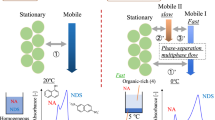Abstract
In this contribution we introduce phase-optimized columns for highly efficient liquid chromatographic separations in microfluidic glass chips. In phase-optimized liquid chromatography the selectivity and geometry of the stationary phase are precisely adjusted to provide an optimal separation of a mixture of interest. The separation of nine polycyclic aromatic hydrocarbons under reversed-phase conditions was investigated. Standard HPLC was utilized to explore the retention parameters of each analyte on a set of five commercially available stationary phases. From these experiments the properties of an optimal on-chip column were calculated assuming a zero-void-volume performance for the chip chromatography. A phase-optimized on-chip column only 30 mm long provided baseline resolution of all signals within 4 min. The separation performance of a chip column comprising various stationary phases can be precisely predicted by a set of traditional HPLC experiments. The approach has great potential for the directed development of tailor-made chromatography chips for specific applications.





Similar content being viewed by others
References
de Malsche W, Eghbali H, Clicq D, Vangelooven J, Gardeniers H, Desmet G (2007) Pressure-driven reverse-phase liquid chromatography separations in ordered nonporous pillar array columns. Anal Chem 79(15):5915–5926
Manz A, Miyhara Y, Miura J, Watanabe H, Miyagi H, Sato K (1990) Design of an open-tubular column liquid chromatograph using silicon chip technology. Sensors Actuators B Chem 1(1–6):245–255
Schlund M, Gilbert SE, Schnydrig S, Renaud P (2007) Continuous sampling and analysis by on-chip liquid/solid chromatography. Sensors Actuators B Chem 123(2):1133–1141
de Malsche W, Op de Beeck J, De Bruyne S, Gardeniers H, Desmet G (2012) Realization of 1×10 6 theoretical plates in liquid chromatography using very long pillar array columns. Anal Chem 84(3):1214–1219
Ocvirk G, Verpoorte E, Manz A, Grasserbauer M, Widmer HM (1995) High-performance liquid-chromatography partially integrated onto a silicon chip. Anal Method Instrum 2(2):74–82
Yin H, Killeen K, Brennen R, Sobek D, Werlich M, van de Goor T (2005) Microfluidic chip for peptide analysis with an integrated HPLC column, sample enrichment column, and nanoelectrospray tip. Anal Chem 77(2):527–533
Gerhardt G (2011) Microfluidics-based separations technology for the analytical laboratory. Chromatogr Today 4(3):6–8
Eksigent Technologies cHiPLC-nanoflex (2010) Product note. www.eksigent.com/Documents/Products/05-cHiPLC-nanoflex_ProdNote_0109_LR.pdf. Accessed 16 Aug 2014
Belder D (2009) Towards an integrated chemical circuit. Angew Chem Int Ed Engl 48(21):3736–3737
Polat AN, Kraiczek K, Heck AJR, Raijmakers R, Mohammed S (2012) Fully automated isotopic dimethyl labeling and phosphopeptide enrichment using a microfluidic HPLC phosphochip. Anal Bioanal Chem 404(8):2507–2512
Chambers AG, Mellors JS, Henley WH, Ramsey JM (2011) Monolithic integration of two-dimensional liquid chromatography−capillary electrophoresis and electrospray ionization on a microfluidic device. Anal Chem 83(3):842–849
Belder D, Ludwig M, Wang L, Reetz MT (2006) Enantioselective catalysis and analysis on a chip. Angew Chem Int Ed Engl 45(15):2463–2466
Fritzsche S, Ohla S, Glaser P, Giera DS, Sickert M, Schneider C, Belder D (2011) Asymmetric organocatalysis and analysis on a single microfluidic nanospray chip. Angew Chem Int Ed 50(40):9467–9470
Ohla S, Beyreiss R, Fritzsche S, Glaser P, Nagl S, Stockhausen K, Schneider C, Belder D (2012) Monitoring on-chip Pictet-Spengler reactions by integrated analytical separation and label-free time-resolved fluorescence. Chemistry 18(4):1240–1246
Jezierski S, Tehsmer V, Nagl S, Belder D (2013) Integrating continuous microflow reactions with subsequent micropreparative separations on a single microfluidic chip. Chem Commun 49(99):11644–11646
Eppert GJ, Heitmann P (2003) Selectivity optimization of stationary phases. LC-GC Europe 16:698–705
Lu J, Ji M, Ludewig R, Scriba GK, Chen D (2010) Application of phase optimized liquid chromatography to oligopeptide separations. J Pharm Biomed Anal 51(3):764–767
Chen K, Lynen F, de Beer M, Hitzel L, Ferguson P, Hanna-Brown M, Sandra P (2010) Selectivity optimization in green chromatography by gradient stationary phase optimized selectivity liquid chromatography. J Chromatogr A 1217(46):7222–7230
Kutter JP (2012) Liquid phase chromatography on microchips. J Chromatogr A 1221:72–82
Thurmann S, Dittmar A, Belder D (2014) A low pressure on-chip injection strategy for high-performance chip-based chromatography. J Chromatogr A 1340:59–67
Ettre LS (1993) Nomenclature for chromatography (IUPAC recommendations 1993). Pure Appl Chem 65(4):819–872
Fekete S, Kohler I, Rudaz S, Guillarme D (2014) Importance of instrumentation for fast liquid chromatography in pharmaceutical analysis. J Pharm Biomed Anal 87:105–119
Acknowledgments
The authors wish to thank iX-factory GmbH for fruitful cooperation in the context of the chip design and Bischoff Analysentechnik und -geräte GmbH for kindly providing the particulate material.
The authors would like to thank for financial aid support the German Federal Ministry of Economics and Technology within the Zentrales Innovationsprogramm Mittelstand (ZIM) and the agenda for the promotion of industrial cooperative research and development (IGF) on the basis of a decision by the German Bundestag. The access was opened by the DECHEMA and organized by the AiF, Arbeitsgemeinschaft industrieller Forschungsvereinigungen, Cologne, Germany (IGF Project No. 392 ZBG).
Author information
Authors and Affiliations
Corresponding author
Additional information
Our work is dedicated to the memory of Klaus Bischoff who passed away during the course of this project.
Rights and permissions
About this article
Cite this article
Thürmann, S., Belder, D. Phase-optimized chip-based liquid chromatography. Anal Bioanal Chem 406, 6599–6606 (2014). https://doi.org/10.1007/s00216-014-8087-y
Received:
Revised:
Accepted:
Published:
Issue Date:
DOI: https://doi.org/10.1007/s00216-014-8087-y




